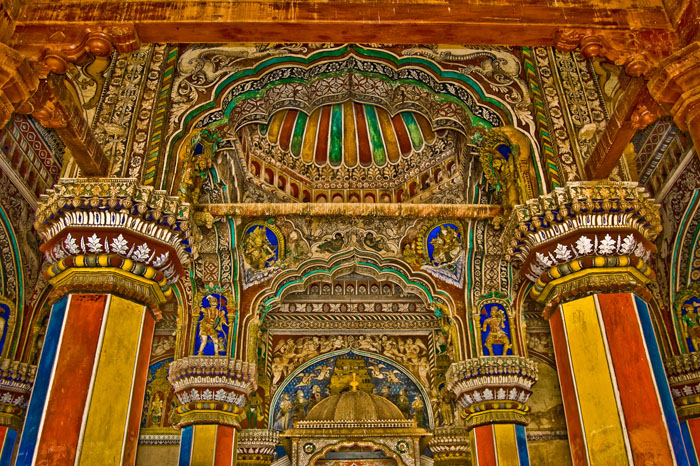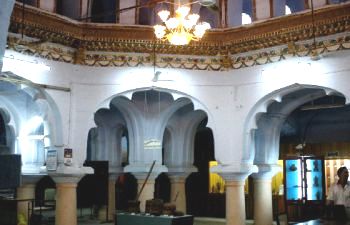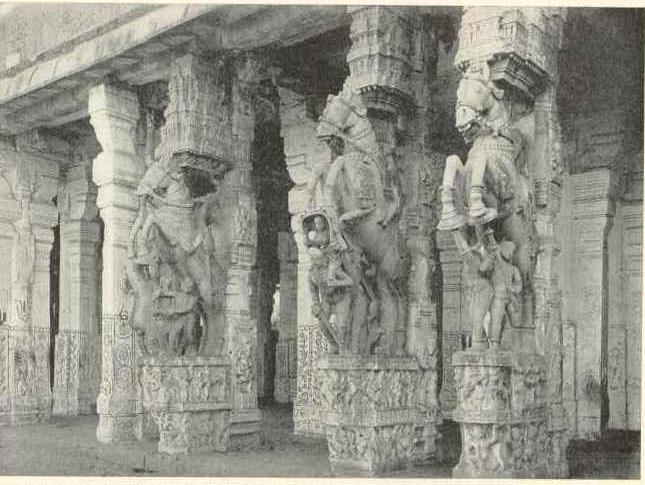|
Ekoji I
Vyankojirajah Bhonsle (born 1632) or Ekoji I Bhonsle was the younger half-brother of Chhatrapati Shivaji Maharaj and founder of Maratha rule in Thanjavur in modern day Tamil Nadu. He was the progenitor of the junior branch (cadet branch) of the Bhonsle family which ruled Thanjavur until the formal annexation of the kingdom by the British East India Company in 1855. Early career Venkoji was the younger son of Shahaji, a military commander in service of the Sultan of Bijapur through his younger wife Tukabai Mohite. He succeeded to the Karnataka portion of Shahaji's jagir, that is Bengaluru and Thanjavur. Conquest of Thanjavur In 1673, the Nayak of Madurai invaded the kingdom of Thanjavur under the rule of the Thanjavur Nayaks and drove away the ruler. He then proceeded to place his younger brother Alagiri Nayak on the throne of Thanjavur. This was resented by Rayasam Venkanna, a high-ranking official in the court of Thanjavur who supported the cause of Chengamala Da ... [...More Info...] [...Related Items...] OR: [Wikipedia] [Google] [Baidu] |
Raja
Raja (; from , IAST ') is a noble or royal Sanskrit title historically used by some Indian subcontinent, Indian rulers and monarchs and highest-ranking nobles. The title was historically used in the Indian subcontinent and Southeast Asia. The title has a long history in South Asia and History of Southeast Asia, Southeast Asia, being attested from the ''Rigveda'', where a ' is a Rigvedic tribes, ruler, see for example the Battle of the Ten Kings, ', the "Battle of Ten Kings". The title has equivalent cognates in other Indo-European languages, notably the Latin Rex (title), Rex and the Celtic languages, Celtic Rix. Raja-ruled Indian states While most of the British Raj, Indian salute states (those granted a Salute#Heavy arms: gun salutes, gun salute by the The Crown, British Crown) were ruled by a Maharaja (or variation; some promoted from an earlier Raja- or equivalent style), even exclusively from 13 guns up, a number had Rajas: ; Hereditary salutes of 11-guns : * the R ... [...More Info...] [...Related Items...] OR: [Wikipedia] [Google] [Baidu] |
Bijapur, Karnataka
Bijapur (officially Vijayapura) is the district headquarters of Bijapur district of the Karnataka state of India. It is also the headquarters for Bijapur Taluk. Bijapur city is well known for its historical monuments of architectural importance built during the rule of the Adil Shahi dynasty. It is also well known for the popular Karnataka premier league team, the Bijapur Bulls. Bijapur is located northwest of the state capital Bangalore and about from Mumbai and north east of the city of Belgaum. The city was established in the 10th–11th centuries during the time of Kalyani Chalukyas and was known as ''Vijayapura'' (city of victory). The city was passed to Yadavas after Chalukya's demise. In 1347, the area was conquered by the Bahmani Sultanate. After the split of the Bahmani Sultanate, the Bijapur Sultanate ruled from the city. Relics of the Sultanates' rule can be found in the city, including the Bijapur Fort, Bara Kaman, Jama Masjid, and Gol Gumbaz. Bijapur, ... [...More Info...] [...Related Items...] OR: [Wikipedia] [Google] [Baidu] |
Ramayana
The ''Ramayana'' (; ), also known as ''Valmiki Ramayana'', as traditionally attributed to Valmiki, is a smriti text (also described as a Sanskrit literature, Sanskrit Indian epic poetry, epic) from ancient India, one of the two important epics of Hinduism known as the ''Itihasas'', the other being the ''Mahabharata''. The epic narrates the life of Rama, the seventh ''avatar'' of the Hindu deity Vishnu, who is a prince of Ayodhya (Ramayana), Ayodhya in the kingdom of Kosala. The epic follows Exile of Lord Rama, his fourteen-year exile to the forest urged by his father King Dasharatha, on the request of Rama's stepmother Kaikeyi; his travels across the forests in the Indian subcontinent with his wife Sita and brother Lakshmana; the kidnapping of Sita by Ravana, the king of Lanka, that resulted in bloodbath; and Rama's eventual return to Ayodhya (Ramayana), Ayodhya along with Sita to be crowned as a king amidst jubilation and celebration. Scholarly estimates for the earliest stage ... [...More Info...] [...Related Items...] OR: [Wikipedia] [Google] [Baidu] |
British East India Company
The East India Company (EIC) was an English, and later British, joint-stock company that was founded in 1600 and dissolved in 1874. It was formed to Indian Ocean trade, trade in the Indian Ocean region, initially with the East Indies (South Asia and Southeast Asia), and later with East Asia. The company gained Company rule in India, control of large parts of the Indian subcontinent and British Hong Kong, Hong Kong. At its peak, the company was the largest corporation in the world by various measures and had its own armed forces in the form of the company's three presidency armies, totalling about 260,000 soldiers, twice the size of the British Army at certain times. Originally Chartered company, chartered as the "Governor and Company of Merchants of London Trading into the East-Indies," the company rose to account for half of the world's trade during the mid-1700s and early 1800s, particularly in basic commodities including cotton, silk, indigo dye, sugar, salt, spices, Potass ... [...More Info...] [...Related Items...] OR: [Wikipedia] [Google] [Baidu] |
Marathi Language
Marathi (; , 𑘦𑘨𑘰𑘙𑘲, , ) is a Classical languages of India, classical Indo-Aryan languages, Indo-Aryan language predominantly spoken by Marathi people in the Indian state of Maharashtra and is also spoken in Goa, and parts of Gujarat, Karnataka and the territory of Dadra and Nagar Haveli and Daman and Diu. It is the official language of Maharashtra, and an additional official language in the state of Goa, where it is used for replies, when requests are received in Marathi. It is one of the 22 scheduled languages of India, with 83 million speakers as of 2011. Marathi ranks 13th in the List of languages by number of native speakers, list of languages with most native speakers in the world. Marathi has the List of languages by number of native speakers in India, third largest number of native ... [...More Info...] [...Related Items...] OR: [Wikipedia] [Google] [Baidu] |
Chokkanatha Nayak
Chokkanatha Nayak (1662—1682) succeeded his father Muttu Alkadri Nayak, as the ruler of the Madurai Nayak dynasty The Madurai Nayakas were a Telugu people, Telugu dynasty * * * * * who ruled most of modern-day Tamil Nadu, India, with Madurai as their capital. The Madurai Nayaks had their origins in the Balija warrior clans of present-day Andhra Pradesh. * ..., when he was sixteen years old. References {{reflist Madurai nayaks Telugu people Telugu monarchs ... [...More Info...] [...Related Items...] OR: [Wikipedia] [Google] [Baidu] |
Nayaks Of Tanjavur
The Thanjavur Nayak dynasty (or Thanjavur Nayak kingdom) were the rulers of Thanjavur in the 15th and 17th centuries founded by Sevappa Nayaka. The Nayaks, who were Telugu Balijas,* * * * * * * * * were originally appointed as provincial governors by the Vijayanagara Emperor in the 15th century, who divided the territory into Nayak kingdoms which were Madurai, Thanjavur and Gingee. In the mid-15th century they became an independent kingdom, although they continued their alliance with the Vijayanagara Empire. The Thanjavur Nayaks were notable for their patronage of literature and the arts. Origins of Nayak rule With the end of the Chola Empire in 1279, Thanjavur was ruled by a branch of Chola dynasty, until the Vijayanagara Empire conquered all of southern India by the late 14th century. In 1532 CE, Achyuta Deva Raya, the brother and successor of Krishna Deva Raya of Vijayanagara Empire, granted Sevappa Nayak, the governor of Thanjavur, the permission to establish a f ... [...More Info...] [...Related Items...] OR: [Wikipedia] [Google] [Baidu] |
Bijapur
Bijapur (officially Vijayapura) is the district headquarters of Bijapur district of the Karnataka state of India. It is also the headquarters for Bijapur Taluk. Bijapur city is well known for its historical monuments of architectural importance built during the rule of the Adil Shahi dynasty. It is also well known for the popular Karnataka premier league team, the Bijapur Bulls. Bijapur is located northwest of the state capital Bangalore and about from Mumbai and north east of the city of Belgaum. The city was established in the 10th–11th centuries during the time of Kalyani Chalukyas and was known as ''Vijayapura'' (city of victory). The city was passed to Yadavas after Chalukya's demise. In 1347, the area was conquered by the Bahmani Sultanate. After the split of the Bahmani Sultanate, the Bijapur Sultanate ruled from the city. Relics of the Sultanates' rule can be found in the city, including the Bijapur Fort, Bara Kaman, Jama Masjid, and Gol Gumbaz. Bijapur, ... [...More Info...] [...Related Items...] OR: [Wikipedia] [Google] [Baidu] |
Ali Adil Shah II
Ali Adil Shah II (; reigned 4 November 1656 – 24 November 1672) was the 8th Sultan of Bijapur. He succeeded to the throne of Bijapur through the efforts of the Prime Minister Khan Muhammad and the Queen, Badi Sahiba, sister of Qutb Shah of Golkonda on the death of Mohammed Adil Shah of Bijapur on 4 November 1656. His accession signaled disasters to the Kingdom and his reign marked the decline of the Bijapur Kingdom. Reign Shah Jahan, anxious to annex Bijapur to his empire, found a pretext in the legitimacy of Ali’s parents. On Aurangzeb’s plea, Shah Jahan sanctioned the invasion of Bijapur and gave him a free hand to deal with the situation. This sanction of such a war was wholly unrighteous. Bijapur was not a vassal state of the Mughals, but an independent and equal ally of the Mughal Emperor, and the latter had no lawful right to confirm or question the succession to the Bijapur Sultanate. However, Aurangzeb had to raise the siege and rush north for the war of su ... [...More Info...] [...Related Items...] OR: [Wikipedia] [Google] [Baidu] |
Alagiri Nayak
Alagiri Nayak was the younger brother of the Madurai Nayak king Chokkanatha Nayak and the last Nayak king of Thanjavur. In 1675, Thanjavur was conquered by Ekoji I, the half-brother of Shivaji who founded the Thanjavur Maratha kingdom The Thanjavur Maratha kingdom ruled by the Bhonsle dynasty, Bhonsle dynasty was a principality of Tamil Nadu between the 17th and 19th centuries. Their native language was Thanjavur Marathi dialect, Thanjavur Marathi. Vyankoji Bhosale was the .... Kings in Asia Madurai Nayak dynasty Thanjavur Maratha kingdom {{Asia-royal-stub ... [...More Info...] [...Related Items...] OR: [Wikipedia] [Google] [Baidu] |
Thanjavur Nayaks
The Thanjavur Nayak dynasty (or Thanjavur Nayak kingdom) were the rulers of Thanjavur in the 15th and 17th centuries founded by Sevappa Nayaka. The Nayaks, who were Telugu Balijas,* * * * * * * * * were originally appointed as provincial governors by the Vijayanagara Emperor in the 15th century, who divided the territory into Nayak kingdoms which were Madurai, Thanjavur and Gingee. In the mid-15th century they became an independent kingdom, although they continued their alliance with the Vijayanagara Empire. The Thanjavur Nayaks were notable for their patronage of literature and the arts. Origins of Nayak rule With the end of the Chola Empire in 1279, Thanjavur was ruled by a branch of Chola dynasty, until the Vijayanagara Empire conquered all of southern India by the late 14th century. In 1532 CE, Achyuta Deva Raya, the brother and successor of Krishna Deva Raya of Vijayanagara Empire, granted Sevappa Nayak, the governor of Thanjavur, the permission to esta ... [...More Info...] [...Related Items...] OR: [Wikipedia] [Google] [Baidu] |
Madurai Nayak
The Madurai Nayakas were a Telugu dynasty * * * * * who ruled most of modern-day Tamil Nadu, India, with Madurai as their capital. The Madurai Nayaks had their origins in the Balija warrior clans of present-day Andhra Pradesh. * * * * * * * * * * * * * * * * * * The Nayak reign which lasted for over two centuries from around 1529 to 1736 was noted for its achievements in arts, cultural and administrative reforms, revitalization of temples previously ransacked by the Delhi Sultans, and the inauguration of a unique architectural style. It was founded by Vishwanatha Nayaka. The dynasty consisted of 13 rulers, of whom nine were kings, two were queens, and two were joint-kings. The most notable among them were king Tirumala Nayaka and queen Rani Mangammal. Foreign trade was conducted mainly with the Dutch and the Portuguese, as the British and the French had not yet made inroads into the region. History Origins The Dalavay Agraharam Plates of Venkata I, ment ... [...More Info...] [...Related Items...] OR: [Wikipedia] [Google] [Baidu] |









